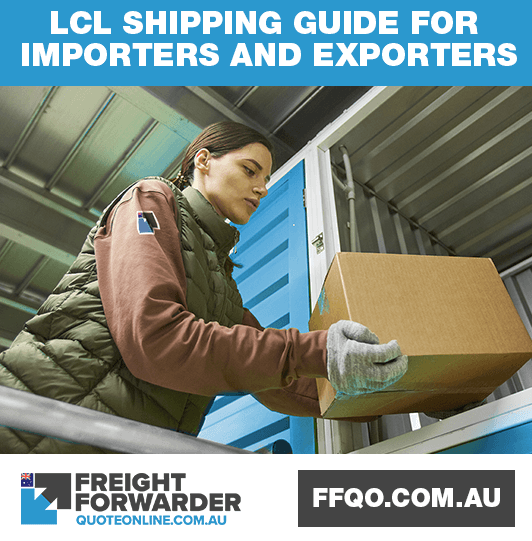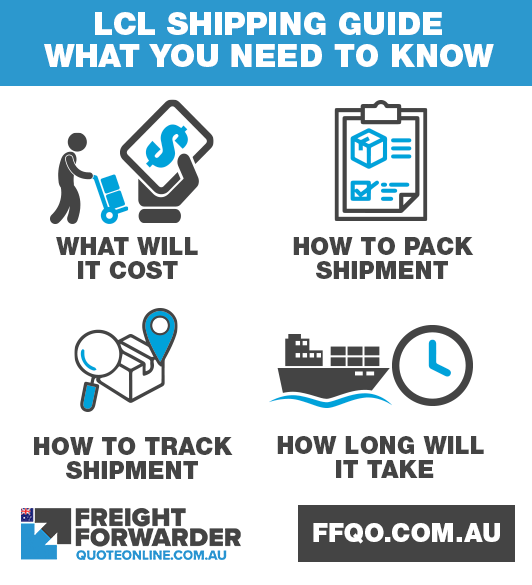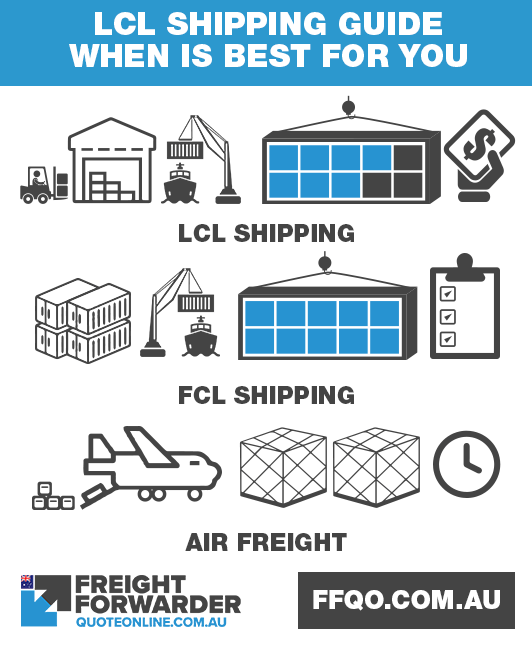Home » News »
LCL shipping guide with sea freight for Australian importers and exporters
« Previous | Next »
This practical LCL shipping guide is essential reading for Australian importers or exporters. No doubt you will be familiar with the acronym ‘LCL’ (‘less than container load’) and that it relates to shipping small volumes of goods. While this is generally correct, it is good to know about the LCL process to make sure you are shipping according to what works best in your situation.

LCL shipping guide with sea freight for Australian importers and exporters
Make sure you know what LCL shipping with sea freight is
LCL (also known as ‘groupage’) covers low- or moderate-volume shipments that need to be loaded together with other shipments in order to fill a container.
How does LCL shipping work
Your LCL consignment must first be consolidated. This means your shipment is warehoused pending arrival of other shipments for groupage. Once there are sufficient parcels of goods to fill a container, the shipment will be transported to a port for clearance and loading onto a vessel.
LCL shipments may sometimes be moved from one container to another during international shipping. Ultimately, however, the container will arrive at a consolidation warehouse for destuffing, that is, the contents unloaded and separated into individual consignments. The goods are then transported to their final destination.
The LCL process is outlined below:
- Choose a carrier
- Share shipment details with carrier
- Cargo leaves shipper’s factory, reaches carrier warehouse
- Carrier processes and consolidates shipment with other LCL packages
- Deconsolidated cargo loaded into container, which is loaded onto ship
- At destination port the container is moved to warehouse
- Shipment deconsolidated and delivered
Advantages
With LCL you pay only for the volume needed. It also works out cheaper than air freight. Shipping smaller volumes frequently can save on inventory space, and in peak season LCL is more readily available than FCL.
LCL is, therefore, the preferred shipping mode for small businesses.
Disadvantages
LCL costs considerably more per cubic metre (CBM) than FCL because of the work involved in this type of shipping,
LCL shipments may stop at multiple ports so transit time may take between five and eight days longer and there is an increased chance of longer delays. There is also risk of damage or loss due to frequent handling of merchandise.
Customs delays and inspections – more likely with LCL shipments due to the mixed container load – may add even more time.

How LCL shipping works
What you need to know when sending my goods using LCL shipping
Learn how much it costs, how long it will take, how to pack your goods and how to track.
How much does cost?
LCL shipments are usually charged by volume (CBM). Weight becomes a factor only when the cargo weighs more than one ton, when freight is charged by the greater of CBM or weight.
To see examples of how to calculate chargeable volume for LCL shipping with sea freight.
Exporters and importers must note that the shipping process covers not just the sea voyage but a longer journey. A freight forwarder’s LCL shipment quote generally covers:
- Picking up from the shipper’s warehouse
- Loading into the container with other shipments.
- Ship journey
- Deconsolidation and deconsolidation at destination
- Truck delivery to destination warehouse
You our online calculator to get a free and instant LCL shipping quote with sea freight.
How long will LCL shipping take?
LCL shipment will take five to eight days longer than a full container load. Any customs intervention will add more time.
How to pack an LCL shipment?
The biggest cause of LCL shipment damage is improper packaging. Here’s what you can do to secure your cargo:
Pack your cargo in boxes designed for exporting goods. Make sure pieces are uniformly/evenly packed. Number each piece of cargo, and label each with booking number, destination country, shipper (exporter) and consignee (importer). Include a ‘Fragile’ tag if needed.
Place the cargo on pallets, secure with straps and wraps, and load the pallets in the container. This is called palletised LCL.
If your cargo is fragile (flat-screen TVs) and should not be stacked, mention this up-front to your freight forwarder.
How to track your LCL shipment
Knowing the whereabouts of your cargo in transit is important., but this can be challenging. FCL shipments can be tracked in real time, but few service providers offer this for LCL shipments. It is, therefore, worth checking what cargo tracking services your provider offers.

LCL Shipping guide what you need to know
How to work out if LCL shipping is the best for you?
Using LCL for low or moderate-volume cargo will help keep your costs down.
Although shipping times may be longer, LCL shipping is useful for small consignments or if there are strategic reasons for shipping smaller quantities.
LCL shipping versus air freight
Both are suitable for small shipments, but which is better for you? This depends on the size, weight, contents and urgency of your cargo:
Air freight is faster and safer, but is more expensive and its prices more volatile.
Ships are getting faster and some services offer Expedited LCL with delivery time almost matching that of air freight.. Airlines do, however, have more restrictions on goods, especially hazardous material. For such merchandise LCL might be a better bet.
LCL versus FCL shipping
LCL seems perfect for shipments that wouldn’t fill a container. FCL, however, may be more cost- and time-effective if your cargo volume is greater than 13 cubic metres.
LCL rates are more stable than FCL. They remain valid for up to three months, while FCL rates remain valid for two weeks.
Cargo content must be factored in. FCL cuts risk of contamination from other cargo so is better for temperature-sensitive and hazardous merchandise. LCL shipments, however, are said to be more securely packed, reducing risk of damage from movement.
Time is also a factor. FCL is better for urgent deliveries, LCL if flexible delivery is acceptable.

LCL shipping guide – when is best for you and your goods
Simple LCL shipping checklist
Before making your LCL booking get quotes from multiple freight forwarders. This will give you an idea of market price and help you ascertain if a quoted price is too low, which might mean there are additional charges involved.
- Look out for any additional/extra costs, including destination charges for port service, terminal handling and security, import processing, documentation and so on
- Take pallet costs into consideration. Pallets take up space, for which you will be charged.
- Booking door-to-door or port-to-door is recommended
Contact us if you need help
If you need help with your LCL shipping, feel free to contact us online or message via our Facebook page. We’re more than happy to help you when importing or exporting your goods from Australia via LCL.
Check out our other recent articles
Latest news
Read up on the latest Australian freight forwarding news and developments:
Marine cargo insurance, should you buy it? - 28 May 2023
Aus UK FTA 2023 highlights in of the new free trade agreement - 07 Apr 2023
Types of cargo shipped via sea freight - 05 Mar 2023

Get social with us
Check us out on Facebook. Get social and like our page. Feel free to post your thoughts - we will appreciate it.
Come see our clips on our YouTube channel and subscribe so you are notified when we add new ones.
To keep up to date with the industry and read up on industry trends and developments, follow us on LinkedIn.
For quick updates, follow us on Twitter.
1300651233